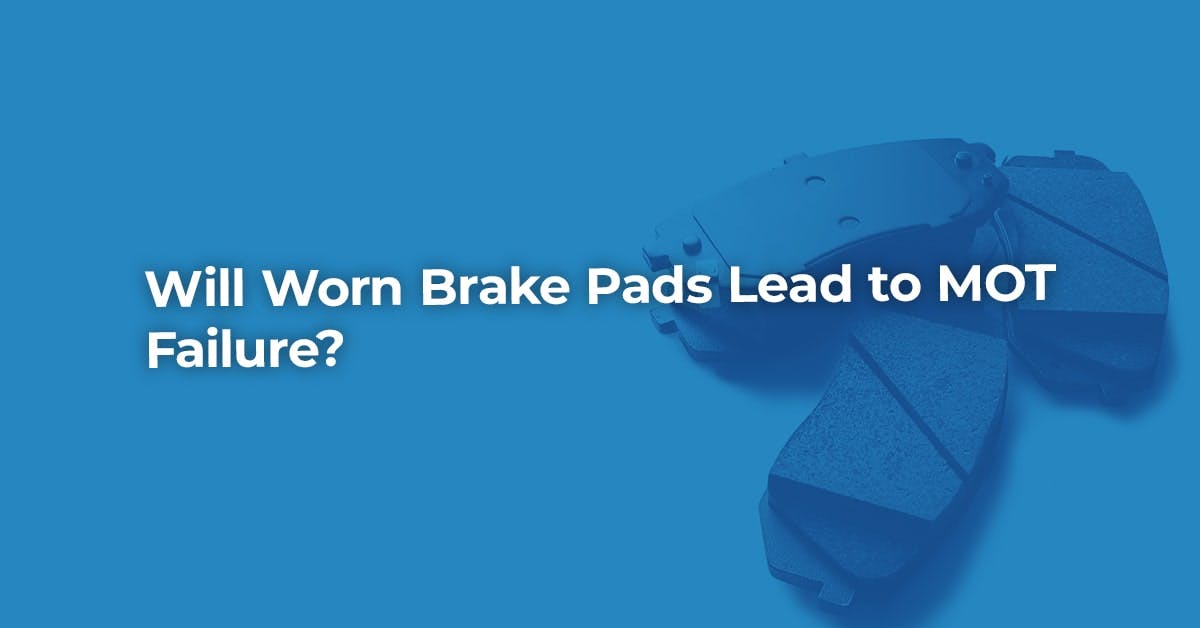It is no surprise that your brake pads will experience wear and tear over time, but can you fail your MOT due to worn out brakes?
Read on and find out which brake problems can result in MOT failure, and why your vehicle might fail its MOT due to worn out brake pads.
Page Contents
Will My Car Fail Its MOT Due to Worn Brake Pads?
During an MOT test, your car’s brake pads and discs will be checked.
Excessively worn brake pads are one of the most common causes of MOT failure.
That being said, you will only fail your MOT test because of the brake pads if they are worn down to the wear indicator or below 1.5mm.
If your brake pads are approaching this legal limit, then you may receive an advisory note instead to have them replaced as soon as possible.
This will likely be the case if your brake pads are below 3mm.
An illuminated brake wear indicator is not a reason for MOT failure.
Which Brake Problems Are Classed as Major and Dangerous MOT Faults?
Here is a selection of brake pad and disc defects and the category of fault they would fall under during the MOT test, based on information taken from the gov.uk website.
Major Defect
- Brake pad worn down to wear indicator
- Brake lining worn down to wear indicator
- Brake pad contaminated with oil or grease
- Brake lining contaminated with oil or grease
- Brake disc or drum significantly worn
- Or contaminated with oil or grease
- Brake drum back plate insecure
Dangerous Defect
- Brake pad or lining worn below 1.5mm
- Brake pad or lining missing
- Or incorrectly mounted
- Brake disc or drum fractured
- Or likely to fail
- Brake disc or drum missing
Please be aware that there are many other brake problems that could be considered major or dangerous faults.
How are My Brakes Tested During an MOT?
An MOT tester will inspect your braking system to determine the efficiency and physical condition of the braking components.
The tester will check a range of braking components which are located under the bonnet, inside or underneath the vehicle.
The MOT tester will check the condition of the following:
- Anti-lock braking system (ABS)
- Brakes
- Brake fluid
- Electronic braking system (EBS)
- Handbrake (parking brake)
The MOT tester will carry out a visual inspection of the brake pads, looking for any wear and tear.
The function of the ABS warning light and its sequence of operation will be checked during the MOT test.
If the footbrake touches the floor, the brake pedal rubber or brake pedal pivot are excessively worn out, or the servo assistance system is not working properly, then your vehicle may fail its MOT.
Likewise, the brake pedal will cause your vehicle to fail the MOT if the grooves or raised grip sections on the pedal are worn smooth.
However, this will not be classed as a fail if the vehicle was manufactured with a brake pedal which does not have grooves or anti-slip material.
Some vehicles have a dashboard warning light which can signal when the brake pads are wearing out - the same light can sometimes light up when the handbrake is applied.
The MOT tester will automatically fail your vehicle if this light is illuminated, and you will have to replace your brake pads so that the car can pass on a retest.
Which Brake Problems Can Result in MOT Failure?
Faulty or worn out brakes can put you in danger whilst driving, and lead to the need for expensive repairs.
As such, there are several common brake problems which can result in MOT failure.
Brake Juddering
You may notice juddering when you apply your brakes.
This can be caused by the brake pads pressing unevenly on the brake discs.
It could also occur if you leave your car parked for days or weeks at a time.
If there is any residue on the brakes caused by hard stopping - or if the discs have warped from keeping your foot on the brake whilst in traffic - then this can also cause this juddering sensation.
If the brake discs have warped, this will result in MOT failure.
Brake Pedal Problems
If the grooves or raised grip sections of the brake pedal are worn smooth, this will lead to MOT failure - unless the vehicle was manufactured with a brake pedal which does not have grooves or anti-slip material.
Contaminated Brake Pads or Linings
When the brake pad lining wears away, this can cause damage to the brake discs, as the metal from the pads can hurt the brake discs and cause them to wear out faster.
If your brake pads or linings are missing, incorrectly mounted or contaminated, then this could lead to a fail.
Contaminated or Leaking Brake Fluid
Brake fluid contamination is classed as a defect, and your vehicle will fail its MOT if it is clearly visible that the brake fluid is contaminated.
If your brake fluid is leaking, this will be classed as a dangerous fault and will fail your car’s MOT.
Some minor defects include the brake fluid being below the minimum level, or the brake fluid warning light being illuminated.
Whilst these might not lead to a failure right away, you will be advised to have these issues resolved as soon as possible.
Damaged or Worn Brake Discs
A brake disc which wears out below the minimum thickness will be classed as a major fault, leading to an MOT fail.
Similarly, a loose brake disc will be seen as a dangerous defect, meaning you cannot drive the vehicle until the defect is repaired.
Defective ABS Warning Light
If your ABS warning light stays on permanently, this can result in an automatic MOT fail.
As the majority of issues with the anti-lock braking system will make it dangerous to try and stop your vehicle in an emergency, it is important that the ABS warning light works properly.
You will need to have the warning light repaired before having your vehicle retested.
Faulty Handbrake
The handbrake (parking brake) could be hand, foot or electronically operated.
During the MOT test, the handbrake lever’s mounting will be inspected for corrosion and security.
On electronic systems, an illuminated parking brake warning light can cause MOT failure.
Are Worn Brake Discs an MOT Failure?
Worn brake discs that are close to minimum thickness will result in an advisory note rather than an MOT failure.
However, a brake disc worn below this minimum will be classed as a major fault and will see your vehicle fail its MOT.
A loose brake disc is viewed as a dangerous defect, meaning the vehicle cannot be driven until this is repaired.
How Do I Look After My Brakes Ahead of an MOT Test?
To give your brake pads the best chance of passing the MOT test, you should replace them when they are less than a quarter of an inch in thickness.
You should also check your brake fluid level ahead of an upcoming MOT test, to reduce the likelihood of your brakes failing the test.
The brake fluid should sit between the minimum and maximum marks under the bonnet.
Be aware of warning signs that suggest your brakes need to be replaced, such as the car pulling to the side.
Ahead of the MOT test, be sure to inspect the brake discs and pads, checking if the surface of the brake disc looks smooth and determining the thickness of the brake pads.
You should also listen for squealing or grinding noises from your brakes, as these sounds can indicate that your brake pads are running low.
Lastly, your handbrake may need an adjustment if you try to stop your car on a hill and apply it and it does not hold the car.
Make sure that you book an appointment at a local garage to have any brake problems fixed ahead of an upcoming MOT test.
If your current MOT is due to expire, be sure to book an MOT test near you at your earliest convenience.








6 replies to "Will Worn Brake Pads Lead to MOT Failure?"
John F Walters
February 2nd, 2024
Eve McPherson
February 5th, 2024
elizabeth mcguinness
April 4th, 2024
Eve McPherson
April 8th, 2024
Carl
December 7th, 2024
Eve McPherson
December 18th, 2024
Leave a comment